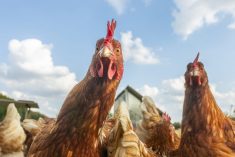Recovery for Alberta’s struggling hog farmers will involve tax-funded offsets for the “vastly inflated” cost of feed grains and a “new business relationship” with the province’s biggest packer, according to the province’s hog farmer organization.
“In order to keep our largest processor (the Olymel pork plant at Red Deer) in Alberta, producers have been forced to accept reduced prices for hogs,” said Alberta Pork executive director Paul Hodgman in a release, rolling out the agency’s industry recovery plan.
“There is an expectation that, by working together (with Olymel), we will see value-added and new market opportunities that will allow both producers and processors to prosper in the long term.”
Read Also

U.S. livestock: Cattle strength continues
Cattle futures on the Chicago Mercantile Exchange were stronger on Friday, hitting fresh highs to end the week.
Olymel aside, Hodgman said, the industry plan also looks to set up a general business climate in which further value-added processing and value chain development can occur.
A key component of the plan is government aid to address hog producers’ cash crunch, with a focus on reducing the impact from higher feed grain prices, Alberta Pork wrote. The organization cited the “vastly inflated” costs of feed due to government policies supporting ethanol production in both Canada and the U.S.
The plan recommends a biofuels offset program “similar to the highly successful Alberta Crow Benefit Offset program from the 1980s” that would provide government aid until feed byproducts are available and new higher-yielding feed varieties are in production.
It also proposes that the government help remove restrictions on registration of high-yielding feed barleys and wheats now limited by federal regulations on kernel visual distinguishability (KVD).
Declining global prices for hogs, combined with a strong Canadian dollar hindering exports, have left Alberta producers facing losses of up to $50 per market hog, the agency said, and many producers are leaving the industry as a result.
- More generally, the recovery plan focuses on four main fundamentals with which Alberta can remain a player in the hog industry worldwide:
- quality, through genetics and disease control;
- knowledge, through trained producers and a strong research base;
- entrepreneurship, through adaptation of new technologies and production techniques; and
- high-quality infrastructure, land, water, feed and access to export markets.
“In order for Alberta producers to seize the opportunities of these huge emerging markets of China and India,” Hodgman said, “we need to ensure the viability of the industry today.”
China is expected to be one of the world’s largest pork importers within five years, he noted.















